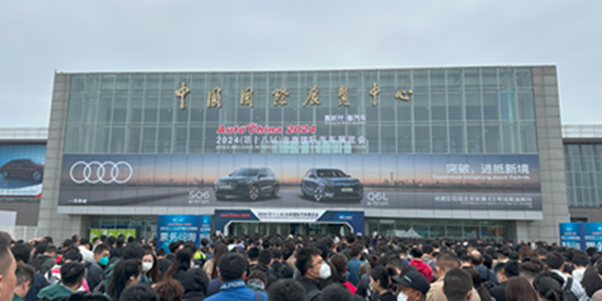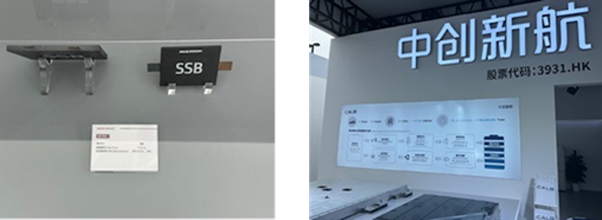By Yunfan Chen, China Mobility Consultant and Dr. Jose Pereira, Europe Mobility Advisory Director, Frost & Sullivan.
On the 25th April, the 18th Beijing International Auto Show, held for the first time in 4 years! Open its doors and captured the attention of global mobility enthusiasts with 117 world premiere vehicles and 278 new energy models, supported by >500 component companies and tech firms from 13 countries and all over the world. Analysts from Frost & Sullivan were present to capture the latest market dynamics. Here are our top takeaways from the event:

1. The Second Half of the EV Race Begins with Emphasis on “Intelligence”
China’s new energy vehicle industry has shifted from focusing primarily on electrification to emphasizing “intelligent” features. In the past, automakers mainly highlighted the driving range of new energy vehicles, but with many now exceeding 500 kilometres, to continue attracting consumers, automakers are improving smart vehicle innovations and further ‘boosting’ the user experience. Companies like BYD with its DiLink, GAC Aion with AdiGO, and NIO with NIO OS, have integrated more advanced AI applications such as Dipilot powered by Xuanji AI model and Banyan smart in-car system, making travel smarter and more comfortable. The entry of tech giants like Huawei and Xiaomi has also intensified competition in intelligent driving hardware and software, and in smart cabins, with XIAOMI emphasizing immersive human-machine interfaces (HMI) and hardware customization with their centre-console and top-tier suppliers such as Horizon, Hesai Lidar, and SenseAuto Empower, showcasing their latest tech products and deepening customization and cooperation with OEMs at the event.
2. International OEMs Show Diverging Approaches to “New Energy” and the Chinese Market
OEMs like Honda and VW demonstrated a renewed commitment to the Chinese EV market and launched a series of localized new energy brands and models to embrace the unique expectations of local consumers in China. For example, Dongfeng Honda showcased its entire NEV lineup, including three electric sedans—the LingGuang e:NS2, LingSi L, and Ye S7—along with hybrid models of the CR-V and Inspire, accelerating their localisation and electrification strategy. Volkswagen has also entered strategic technological cooperation with XPENG to develop two B-class electric vehicle models based on the G9 platform. Leveraging the intelligent cockpit and advanced driver-assistance systems software of XPENG, they will be sold under the Volkswagen brand in China with production expected to start in 2026, reinforcing VW’s in “China for China strategy” and helping XPENG promote its E/E platform in Europe as well. In contrast, some international OEMs still focused on promoting standard combustion engine models, like JLR and Infinity, while other European OEMs such as Peugeot and Citroën did not participate in this year’s Auto China show. These OEMs insisted on promoting traditional virtues of ICE models improved with smarter HMI based driving experiences similar to their EV competitors, believing that by offering traditional performance, reliability and sticking to traditional quality and refinement attributes, they can weather the current market slowdown in China.
3. Chinese New Energy OEMs Enter an Era of Intense Competition
The internal competition among Chinese new energy brands is an all-time high, and was reflected in both pricing and configuration. In February 2024, BYD led the first move in a price reduction trend that saw prices of domestic new energy hybrid models drop to the 10,000 EUR range for the first time. Subsequently, Wuling Motors, SAIC Volkswagen, Nissan, Chery, and Geely joined the wave of price cuts, launching various discount policies to defend and capture market share. At the Auto China Show, features like 800V high-voltage platforms, high-density batteries, electric suction doors, and standard intelligent driving capabilities, have become the norm for most Chinese OEMs, leading to flagship versions having similar configurations and performance, significantly differing from similar models from overseas OEM’s. It will be interested to monitor sales in 2024 to see how customers respond to the range of new brand innovations and products on offer.
4. Chinese and Global Tier 1 and testing service provider shined at the show
Chinese and international automotive testing companies led a series of discussion at the Beijing Auto Show. APTIV showcased software and hardware platforms and products developed by its local team, including architectures supporting advanced automated driving and electrification, as well as software architectures enabled by cloud-native methods, helping automakers accelerate the transition to “software-defined vehicles.” Brands like KOTEI independently developed the KCarOS high-quality SOA software platform for HPC architectures, accelerating the full-domain, full-stack design process from vehicle architecture design to software development through AI-based intelligent development tools. Their ability to achieve faster, smarter, and higher-quality product iteration upgrades has attracted the attention of many Chinese and international OEMs. The bustling event was certainly not lacking in presence from Tier 1 giant Bosch. Bosch showcased its wide range of solutions, fully demonstrating its latest innovations aimed at a sustainable smart mobility future. The company grandly introduced a flexible portfolio that offers both integrated and decoupled hardware and software solutions, such as the new cross-domain solution—the Vehicle Motion Control System. This system is said to comprehensively cover software and system solutions for managing six degrees of freedom in vehicle movement, based on sensor data from the entire vehicle. Valeo also showcased at Auto China its newly optimized three-in-one electric drive system, featuring the latest generation 800-volt silicon carbide inverter, which increases efficiency by 5% and power density by 40%. Moreover, its fourth-generation onboard charger not only charges the battery but can also feed energy back into the grid, providing power for the future smart grid.
5. The Circular Economy May Become a Crucial Future Topic
Battery companies like CATL were also a major attraction at the Beijing Auto Show, with various firms introducing new solid-state battery innovations, which are expected to find their way into new products in ~3 years albeit in limited initial series production, as well as battery recycling solutions. China already dominates when it comes to preprocessing and battery materials recovery, however, as policies and enforcement related to battery recycling new energy vehicle batteries are not yet fully defined in China, there is much work to do still for a more mature battery recycling ecosystem in China to emerge.
As leaders in the battery industry, both CATL and BYD have already heavily invested in the battery recycling economy. CATL, specifically, increased its holdings in Brunp Recycling in 2013 and 2015, owning 69.02% of its shares; in 2019, CATL formed a joint venture with Brunp with an investment of 3.6 billion yuan. This move expanded its upstream cathode material layout and introduced the concept of integrating “upstream and downstream” recycling, pioneering China’s used battery recycling system. Currently, CATL has established 15 recycling centers across the country. BYD, on the other hand, was one of the first companies to enter into a strategic cooperation with China Tower Corporation for the cascading use of batteries (re-use). Shanghai BYD is listed in the second batch of the white list for the comprehensive utilization of retired power batteries according to the industry specification conditions set by the Ministry of Industry and Information Technology (cascading utilization). Additionally, BYD is exploring the application of retired batteries in energy storage with the Japanese trading company Itochu Corporation. To date, BYD has established over 40 power battery recycling centers nationwide.
6. Hydrogen Era in Mobility Still Requires Time
The transition to the hydrogen era in mobility is proving to be a slow process. At this year’s Auto Show, most companies did not feature hydrogen-powered vehicles, except for BMW, which showcased a hydrogen-powered iX5 SUV. However, BMW has not announced any specific plans for its market release. The development of hydrogen vehicles for consumer use in China faces several challenges, including infrastructure limitations, which involve the high costs and complex logistics of building a network of hydrogen stations. Additionally, the technology itself is still maturing, with issues such as fuel cell durability and efficiency needing further advancement. Furthermore, regulatory and safety concerns, given hydrogen’s high flammability, necessitate stringent safety protocols and can slow down technology adoption and infrastructure development, collectively contributing to the slow adoption of hydrogen vehicles in China and elsewhere.
Conclusion:
Auto China 2024 showcased the emergence and rise of new energy brands like XIAOMI, NIO & GAC demonstrating high-end intelligent driving mass production solutions. Notable also was the presence and international ambitions of Chinese testing companies and Tier 1 suppliers, which are now able to offer market-leading advice and solutions, especially in the SDV domain. The show featured the coexistence of PHEVs and BEVs on the show floor demonstrating that there is still a market for both powertrains even as BEV’s continue to dominate. The event highlighted the starkly different attitudes towards electrification and competition between Chinese OEMs and international OEMs however, with local OEMs continuing to focus on tailoring vehicle specifications to suit local needs, emphasizing immersive human-machine interfaces (HMI) and hardware customization, over extended driving range and other traditional performance attributes. International OEMs seem to have realized that additional technology partnership will be required to better compete in the rapidly evolving market, with VW looking to adopt XPENG E/E architecture for local products and even Tesla announcing a collaboration with internet giant Baidu for assisted driving technology development.
Our discussions at the Beijing Auto Show also touched on current market challenges such as production overcapacity and global exports, growing concerns about data privacy protection and security in an SDV world, and the viability of a truly circular battery economy, all topics which must warrant continued focus and consideration by all mobility stakeholders and experts who want to see an innovative and sustainable industry continue to thrive in the future.
To learn more, please access our Mobility growth advisory team experts by contacting jose.pereira@frost.com or for more information into our wide range of subscription-based Mobility research please contact sathyanarayanak@frost.com for a private briefing.





